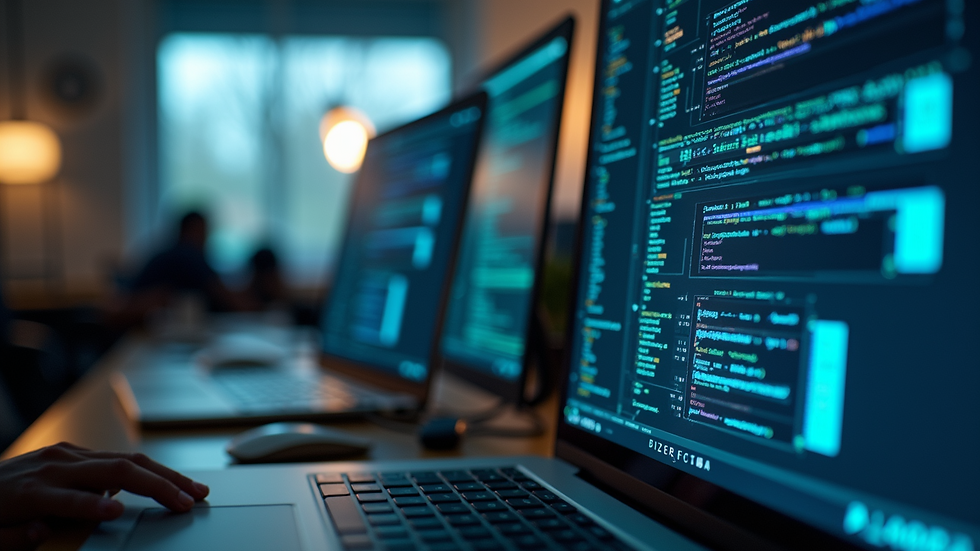Enhance Enterprise Efficiency with Hardware-Optimized AI Solutions
- jaishubham
- Aug 6
- 4 min read
In today's fast-paced business world, efficiency is key. Companies are constantly looking for ways to streamline operations and improve productivity. One of the most promising avenues for achieving this is through hardware-optimized AI solutions. These technologies can transform how businesses operate, making processes faster and more efficient.
In this blog post, we will explore what hardware-optimized AI solutions are, how they work, and the benefits they bring to enterprises. We will also look at real-world examples of companies that have successfully implemented these solutions.
What Are Hardware-Optimized AI Solutions?
Hardware-optimized AI solutions refer to systems designed specifically to run artificial intelligence algorithms more efficiently. Unlike traditional software solutions that run on general-purpose hardware, these systems leverage specialized hardware components. This can include graphics processing units (GPUs), tensor processing units (TPUs), and field-programmable gate arrays (FPGAs).
These specialized components are built to handle the heavy computational demands of AI tasks. They can process large amounts of data quickly, which is essential for tasks like machine learning and deep learning.
By using hardware-optimized solutions, businesses can achieve faster processing times, reduced energy consumption, and improved performance.
The Benefits of Hardware-Optimized AI Solutions
1. Increased Speed and Efficiency
One of the most significant advantages of hardware-optimized AI solutions is speed. Traditional systems can struggle with the complex calculations required for AI tasks. In contrast, specialized hardware can perform these calculations much faster.
For example, a company using GPUs for machine learning can see a significant reduction in training time. This means that businesses can get insights from their data more quickly, allowing for faster decision-making.
2. Cost Savings
While the initial investment in specialized hardware may be higher, the long-term savings can be substantial. Faster processing times mean that tasks can be completed in less time, reducing labor costs. Additionally, optimized hardware often consumes less energy, leading to lower utility bills.
3. Enhanced Performance
Hardware-optimized AI solutions can handle more complex tasks than traditional systems. This allows businesses to tackle more challenging problems and gain deeper insights from their data.
For instance, a retail company might use AI to analyze customer behavior and optimize inventory management. With specialized hardware, the analysis can be done in real-time, leading to better stock management and increased sales.
4. Scalability
As businesses grow, their data needs often increase. Hardware-optimized AI solutions can scale more easily than traditional systems. Companies can add more specialized hardware as needed, ensuring that they can handle larger datasets without a drop in performance.
5. Improved Reliability
Specialized hardware is often more reliable than general-purpose systems. This is because it is designed specifically for AI tasks, reducing the chances of errors and system failures.
Businesses can trust that their AI solutions will perform consistently, which is crucial for maintaining operations and meeting customer expectations.
Real-World Examples of Hardware-Optimized AI Solutions
Example 1: Tesla
Tesla is a prime example of a company leveraging hardware-optimized AI solutions. The company uses custom-built chips in its vehicles to process data from sensors and cameras. This allows for real-time decision-making in its autonomous driving systems.
By optimizing hardware for AI tasks, Tesla can improve the performance of its self-driving technology, making it safer and more efficient.
Example 2: Google
Google has invested heavily in hardware-optimized AI solutions, particularly with its Tensor Processing Units (TPUs). These chips are designed specifically for machine learning tasks.
Google uses TPUs in various applications, from search algorithms to image recognition. The result is faster processing times and improved accuracy, which enhances user experience across its platforms.
Example 3: Amazon
Amazon uses hardware-optimized AI solutions in its fulfillment centers. The company employs robots that use AI to navigate and manage inventory. These robots are equipped with specialized hardware that allows them to process data quickly and efficiently.
This optimization leads to faster order processing and improved accuracy in inventory management, ultimately enhancing customer satisfaction.
Implementing Hardware-Optimized AI Solutions in Your Business
Step 1: Assess Your Needs
Before implementing hardware-optimized AI solutions, it is essential to assess your business needs. Consider the specific tasks you want to optimize and the data you will be working with.
This assessment will help you determine the type of specialized hardware that will best suit your requirements.
Step 2: Choose the Right Hardware
Once you have a clear understanding of your needs, the next step is to choose the right hardware. Research different options, such as GPUs, TPUs, and FPGAs, to find the best fit for your business.
Consider factors like processing power, energy efficiency, and cost when making your decision.
Step 3: Train Your Team
Implementing hardware-optimized AI solutions requires a skilled team. Ensure that your staff is trained to work with the new technology. This may involve upskilling existing employees or hiring new talent with the necessary expertise.
Step 4: Monitor and Optimize
After implementation, it is crucial to monitor the performance of your hardware-optimized AI solutions. Regularly assess how well the system is meeting your business needs.
Be prepared to make adjustments as necessary to ensure optimal performance.
The Future of Hardware-Optimized AI Solutions
As technology continues to evolve, hardware-optimized AI solutions will become even more critical for businesses. The demand for faster, more efficient systems will only grow as companies seek to stay competitive.
Emerging technologies, such as quantum computing, may also play a role in the future of AI. These advancements could further enhance the capabilities of hardware-optimized solutions, allowing businesses to tackle even more complex challenges.
Final Thoughts
Incorporating hardware-optimized AI solutions can significantly enhance enterprise efficiency. By leveraging specialized hardware, businesses can achieve faster processing times, cost savings, and improved performance.
As more companies recognize the benefits of these solutions, the landscape of business operations will continue to evolve. Embracing this technology now can position your business for success in the future.



Comments